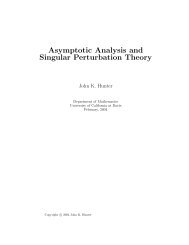The Riemann Integral
The Riemann Integral
The Riemann Integral
Create successful ePaper yourself
Turn your PDF publications into a flip-book with our unique Google optimized e-Paper software.
42 1. <strong>The</strong> <strong>Riemann</strong> <strong>Integral</strong><br />
Similarly, if f : (−∞,b] → R is integrable on [r,b] for every r < b, then<br />
∫ b<br />
−∞<br />
f = lim<br />
r→∞<br />
Let’s consider the convergence of the integral of the power function in Example<br />
1.68 at infinity rather than at zero.<br />
Example 1.70. Suppose p > 0. <strong>The</strong> improper integral<br />
∫ ∞ ∫<br />
1 r<br />
(<br />
1 r 1−p )<br />
−1<br />
dx = lim dx = lim<br />
xp r→∞ xp r→∞ 1−p<br />
1<br />
1<br />
converges to 1/(p − 1) if p > 1 and diverges to ∞ if 0 < p < 1. It also diverges<br />
(more slowly) if p = 1 since<br />
∫ ∞<br />
1<br />
1<br />
dx = lim<br />
x r→∞<br />
∫ r<br />
1<br />
∫ b<br />
−r<br />
f.<br />
1<br />
dx = lim lnr = ∞.<br />
x r→∞<br />
Thus, wegetaconvergentimproperintegralifthe integrand1/x p decayssufficiently<br />
rapidly as x → ∞ (faster than 1/x).<br />
A divergent improper integral may diverge to ∞ (or −∞) as in the previous<br />
examples, or — if the integrand changes sign — it may oscillate.<br />
Example 1.71. Define f : [0,∞) → R by<br />
f(x) = (−1) n for n ≤ x < n+1 where n = 0,1,2,....<br />
<strong>The</strong>n 0 ≤ ∫ r<br />
0 f ≤ 1 and ∫ n<br />
0<br />
f =<br />
{<br />
1 if n is an odd integer,<br />
0 if n is an even integer.<br />
Thus, the improper integral ∫ ∞<br />
0<br />
f doesn’t converge.<br />
More general improper integrals may be defined as finite sums of improper<br />
integrals of the previous forms. For example, if f : [a,b]\{c} → R is integrable on<br />
closed intervals not including a < c < b, then<br />
∫ b<br />
∫ b<br />
f = lim f + lim f;<br />
a a ǫ→0 + c+ǫ<br />
and if f : R → R is integrable on every compact interval, then<br />
∫ ∞<br />
−∞<br />
δ→0 + ∫ c−δ<br />
f = lim<br />
s→∞<br />
∫ c<br />
−s<br />
f + lim<br />
r→∞<br />
where we split the integral at an arbitrary point c ∈ R. Note that each limit is<br />
required to exist separately.<br />
Example 1.72. If f : [0,1] → R is continuous and 0 < c < 1, then we define as an<br />
improper integral<br />
∫ 1<br />
0<br />
∫<br />
f(x)<br />
c−δ<br />
dx = lim<br />
|x−c|<br />
1/2<br />
δ→0 + 0<br />
∫ r<br />
c<br />
f,<br />
∫<br />
f(x) 1<br />
dx+ lim<br />
|x−c|<br />
1/2<br />
ǫ→0 + c+ǫ<br />
<strong>Integral</strong>s like this one appear in the theory of integral equations.<br />
f(x)<br />
dx.<br />
|x−c|<br />
1/2
















